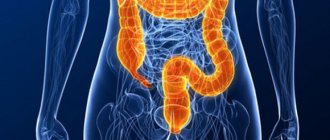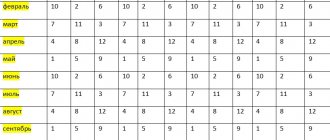Every young mother is tormented by the question of whether everything is okay with her breast milk. The baby is capricious - we are looking for a problem in ourselves, eats poorly - we are sinning on the quality of breast milk, does not go to the toilet - the mother’s diet is to blame. Such self-flagellation does not lead to anything good. As a rule, the issue of breastfeeding is of greater concern, since every second mother considers her baby to be malnourished.
Pediatricians are convinced that a normal appetite and sufficient weight gain mean that the baby has enough of everything. This means that there is no need to supplement the baby with formula or change the nutritional value of the milk. Many mothers, in pursuit of thick and fatty milk , forget that excessive fat content in “food” can provoke childhood dysbiosis. Are there any signs that breast milk is good and nothing needs to be changed?
Are standards needed?
The quality of breast milk is not only an indicator of the percentage of fat. It contains a huge variety of different substances:
- vitamins;
- macro and microelements;
- proteins;
- carbohydrates;
- fats;
- immunoglobulins;
- bactericidal substances;
- lysozyme;
- lactoferin.
The ratio of components is purely individual for each woman in labor. The composition of a woman's milk is tailored to the specific needs of her child. Moreover, it is constantly changing. After all, the needs of a newborn are significantly different from the needs of a 6-month-old baby or a one-year-old child. Women in labor have colostrum. 4-5 days after birth, the mammary glands fill with transitional milk. By the end of 2 weeks it becomes mature. The process of changing components continues throughout the entire GW.
The generally accepted indicators are very approximate. But still, certain guidelines exist. 100 g of human milk contains:
- about 80 – 88 g of water;
- 1 – 1.5 g protein;
- 6 – 7 g carbohydrates;
- 4 – 4.5 g fat.
When laboratory tests give such figures, the mother can be sure that her baby is getting everything she needs. But even with deviations, panic is inappropriate.
Heredity
The nutritional value of milk may depend on heredity. Did your mother care about increasing the fat content of breast milk? You will probably be familiar with the same problem. For some women, oiliness goes through the roof, despite what is included in their diet. For others, it's the opposite. They try to diversify and balance the menu, but the result is zero. This does not mean that some will successfully feed the baby, while others are doomed to use formula. Low fat? And it is not necessary! Your milk is the most suitable product for your baby. Cast aside your doubts and continue feeding.
Generally accepted measures
Every grandmother will tell you how to increase the fat content of milk during breastfeeding. Many modern women also use these recipes. Below is a list of foods that are commonly consumed in order to improve the quality and nutritional value of a baby’s natural food.
- tea with condensed or whole milk;
- nuts (especially walnuts) or sunflower seeds;
- tincture made from full-fat milk and nuts;
- butter;
- cottage cheese and high-fat cheeses;
- meat and liver;
- Cahors wine.
Watching the child
The composition of milk depends on many factors and changes daily. This means that the analysis of breast milk for fat content is relevant only on the day of delivery. There is no better expert than your own child. There are a number of signs indicating that the baby is not starving:
- Weight is gained in accordance with the norm;
- While awake, the baby is quite active;
- Peaceful day and night sleep;
- Night feedings 2 – 3 times;
- During the day, the baby does not endlessly demand the breast;
- There are no problems with defecation;
- There is no reasonless crying.
Watching your child play happily and sleep serenely, you draw the appropriate conclusion. No determining method will be as reliable as the general condition and development of the toddler.
The baby's well-being does not depend on the amount of fat obtained from mother's milk. There is no point in trying to artificially increase oiliness. Moreover, too much fatty food is harmful to the baby. For example, he may become constipated.
If you still suspect that the calorie content is insufficient, conduct an experiment at home. Sometimes, after self-testing, there is no need for testing.
When a problem occurs
Caring parents believe that it is their baby who is malnourished and is not gaining weight well. Women begin to especially worry 3-7 months after giving birth.
Experts say that in fact, as the child ages, the nutritional value of milk does not decrease. If the baby gains less weight over time, then the reason for this is his activity. In the first three months, it is quite natural for children to gain up to 1 kg. But by six months you can’t expect such numbers. No matter how much the mother tries to use various means that increase the amount of fat, the baby will not weigh more.
The baby is crying, does he want to eat?
How to check the fat content of breast milk if the child’s behavior is alarming? Yes, the baby’s calmness and healthy appearance are the main signs. But children tend to get sick. There are periods of teething. Babies often suffer from colic. Perhaps the child feels discomfort and cries because of this.
Mothers, distraught from the suffering of their little one, are ready to attribute this phenomenon to anything. And first of all, as a rule, a child’s crying is perceived as a signal that he is hungry. Before you are tormented by doubts about the quality of milk, make sure that there are no other reasons for whims. Most difficulties are temporary. Sometimes you have to be patient. Running to the laboratory with milk every week is not an option.
Correct application
To make the milk richer, you need to properly attach the baby to the breast. This way the baby can get more nutritious hind milk.
If the attachment is correct, the baby captures most of the areola of the nipple. Feeding in the correct position guarantees the absence of cracks, stagnation of milk, mastitis, and pain when sucking.
How to properly attach your baby:
- Make yourself comfortable. The mother should take a comfortable position, straighten up, and not hang over the child. The baby lies at breast level with the nursing mother, the head is slightly thrown back to open the mouth wider. He cuddles up to his mother, his back is straight.
- Bring your baby's head closer so that your nipple points toward your baby's nose.
- Place your palm under the base of the head and shoulders, tilt the baby's head back slightly.
- Bring your baby to your breast and insert the nipple into your wide-open mouth to capture most of the lower areola.
A hungry baby opens his mouth and presses his tongue to his lower jaw. When he takes the breast, the nipple is deep in the mouth, the cheeks are slightly swollen, and the nose does not rest anywhere and breathes freely.
Determination of milk fat content
Readers of Ogrudnichke.ru recommend: - Review of the most popular vitamin supplements for children from Garden of Life Read the article >>> - How can Earth Mama products help young parents care for their infants? Read the article - Dong Quai is an amazing plant that helps maintain youth in the female body Read more... - Vitamin complexes, probiotics, omega-3 from Garden of Life, designed specifically for pregnant women Find out more >>>
It is quite possible to check the nutritional value of breast milk at home. It should be taken into account that there is “front” and “hind” milk. The child needs the first to quench his thirst, and the next one satiates him. Initially, milk has a lower percentage of fat content. With each sip, the nutritional value of the food increases. Once you decide to do the test, express your hind milk.
Method No. 1: determining fat content by color
Milk that is bluish in color has less oiliness than white milk with a yellowish tint.
Method No. 2: test tube research
Take a test tube or other small container. Put a mark on it. Fill with breast milk to the line. Leave for 5 – 6 hours. During this time the cream will collect. Your task is to measure their thickness. This is easy to do with a ruler. Each millimeter is equal to one percent fat content. We already know that the optimal fat content is 4%. This means the norm is 4 mm of cream.
The child is hungry, what is the reason?
A hungry baby will let you know about it. If crying is heard in the house around the clock, the baby continually asks for the breast, and having received what she wants, she greedily grabs the nipple - there is a reason to look for the reasons for this behavior. It's not always about the calorie content of mother's milk.
Incorrect attachment to the breast
When the nipple is poorly latched, it takes too much effort to suck the milk out. Moreover, the efforts expended were not crowned with success. The child does not receive enough nutrients. To avoid this scenario, make sure your baby is latching onto the nipple correctly. His lower lip should be everted, and his aureole should be almost completely in his mouth. The milk flow is good - the baby is full.
The baby eats only foremilk
Another probable reason is that the baby does not have time to reach the hind milk during feeding. This happens when the mother switches from one breast to another too quickly. It turns out that the baby drinks watery liquid from one breast, it is taken from him and transferred to the other. In the first breast, more nutritious food remains unused, and the baby is already suckling on the other, again absorbing thin milk.
Adviсe
To improve the lactation process, you need to follow simple rules. If you follow these tips, the child will gain weight steadily, and the mother will maintain her health.
- Do not express foremilk. Despite its liquid, it is vital for the child, as it quenches his thirst.
- Don't take your baby off the breast too early. Let him stop sucking when he is completely satisfied.
- Do not follow the feeding schedule strictly. Focus on the child's need and give him milk when he demands.
- Drink enough water. Don’t ignore your thirst; be sure to quench it with clean liquid without harmful impurities.
- Do not alternate breasts during feeding.
- Lead a healthy lifestyle, sleep at least 8 hours and try to breathe fresh air as often as possible.
In most cases, problems with lactation are a figment of the imagination of caring mothers. But if your concern is justified, consult a doctor. A specialist will tell you what the problem is and how to improve the quality of milk.
- A young mother should understand that her health is closely related to the condition of the baby. It is very important to get enough sleep; this is the only way to give your child everything he needs for normal development.
- You need to eat right, preferably at set hours. This will have a beneficial effect on both the health of the woman and her child.
- Make sure your baby has a good latch on the nipple. The mouth should be open wide, with the lower lip turned outward.
- Try to put your baby to your breast as long as possible; the “replacement mother” can wait.
- Expressing to the last drop is not always advisable. If the chest is not very full, then there is no need for this.
Consultation with a specialist
Once you are convinced that your actions are correct, you may be puzzled by the question of how to check the fat content of breast milk. Home tests and laboratory tests sometimes show that the nutritional value is actually reduced. But this is not yet a reason to run for formula to supplement the baby’s feeding.
Consult your pediatrician first. By offering your baby other foods, you reduce his need for your milk. You risk reducing lactation. Perhaps the crisis is temporary. There are different ways to make breast milk more nutritious. Ask a specialist for advice.
Preserving the nutritional value of mother's milk
Take care of the quality of milk in a timely manner. To do this, follow these simple rules:
- Maintain sufficient duration of meals. Let the baby stay at the breast until he has emptied one of them. Remember that hind milk is fattier;
- Alternate your breasts correctly. Do not try to force your baby to eat milk from both breasts at one feeding. One feeding - left, the next - right;
- Pump if necessary. The more fluid left in the breast, the less fat content;
- Eat right. What gets into her blood depends on the diet of a nursing woman. And blood and lymph take part in the creation of milk - the relationship is obvious;
- Allow yourself to rest. Try to get enough sleep, don’t get nervous over trifles and don’t bring yourself to a state of exhaustion.
Nature made sure that mother's milk was adapted to the needs of the child. It is stupid to interfere with the lactation process unless absolutely necessary. It is not always advisable to stuff yourself with walnuts and try to absorb more tea with condensed milk. Be reasonable! Happy motherhood!
What foods should you not eat while breastfeeding?
One of the key factors for successful breastfeeding is the mother’s correct diet. It should include proteins, poly- and monounsaturated fats, complex carbohydrates and fiber. For weak lactation, you need to use the most effective lactogens:
- Cereals. The most useful are oatmeal, pearl barley, brown rice and bulgur. They accelerate the synthesis of prolactin and provide energy to mother and child.
- Whole wheat bread. It is rich in vitamins B and E, which enhance the secretion of breast milk, as well as complex carbohydrates.
- Meat. To increase the protein content in milk, a nursing mother needs to eat turkey, chicken, and lean veal.
- Spinach and beet tops. Vitamin C and iron contained in leafy vegetables help restore lactation in anemia.
- Carrot. This root vegetable contains beta-carotene, which speeds up the production of mother's milk and improves its taste.
- Apricot. Potassium in the fruit works as a metabolism stimulant.
- Fatty fish. Salmon, mackerel, salmon enrich the mother's body with Omega-3 fatty acids, which improve the synthesis of hormones and enzymes.
- Garlic. Just 1-2 slices of the spicy vegetable per day will increase lactation by 5%. To reduce the intensity of the odor, you can add garlic to stews or soups.
- Cow's milk. It contains a special secretion called iga, which forms antibodies that are useful for the baby’s intestines.
- Black sesame. It not only stimulates the production of breast milk, but also saturates it with calcium.
- Dill and basil. Fragrant greens contain a lot of lactogenic substances and vitamin C.
Some drinks also increase the secretion of breast milk - barley decoction, coconut water, artificial coffee made from chicory or dandelion roots.
All mothers have knowledge that breast milk is divided into “front” and “hind”. The first variety has a lighter shade. The baby receives this milk to quench his thirst, since the fat content in it is minimal. If the baby falls asleep within 5 minutes of feeding, it is advisable to express a little “natural food” so that the baby receives more nutrients from hind milk, which has a sufficient level of fat content. Frequently changing breasts during one feeding is not recommended.
If necessary, you can increase the volume of hindmilk. To do this, it is advisable to put the baby to the breast more often. This increases the fat level.
Pediatricians believe that the composition of milk does not always directly depend on the diet of a young mother. They say that the lactation process occurs thanks to lymph and blood, so it does not matter what foods a woman consumes. However, proper nutrition contributes to the smooth functioning of the whole body, which contributes to the further production of high-quality and fatty milk. Food always plays an important role in a person's life, so you should carefully choose fresh and balanced food.
First of all, the diet should be varied. Fruits and various cereals should occupy a special place (at least 50 percent) in the menu of young mothers. Carbohydrates should always be present in food. The amount of fatty foods should not exceed 30 percent. Vegetables are irreplaceable and important products for women.
The preferred protein level is 20 percent. This includes beef, veal and lean fish. The following foods should predominate in the diet: milk, cottage cheese, beans, cabbage, spinach, fish and meat. If a nursing mother has any doubts about the level of fat content in breast milk, she should contact a specialist who will take the necessary tests and select a suitable diet.
A new mother should drink as much fluid as possible per day. If necessary, specialists can prescribe a special tea that helps increase lactation and milk fat content.
If a mother manages to maintain lactation, then this is invaluable for the development of the baby’s immunity. The first thing you need to pay attention to is that the nursing mother has a sufficient amount of milk, and only then you should take care of its fat content. To always have enough, it is recommended to adhere to the following tips:
- No need to be nervous. It is advisable to limit yourself from stress, as it primarily affects the lactation process.
- While feeding, you need to think about the good and focus on the baby. You shouldn't talk, etc.
- The baby needs to be fed on demand. The more often he sucks at the breast, the more milk it will produce. If the mother strictly adheres to the regime, and the baby wants to eat, then whims and crying will not make anyone feel better.
- It is necessary to monitor your diet. During feeding, it is advisable to avoid fatty and spicy foods. The emphasis should be placed not on restriction, but on healthy food. You need to eat often, but in small portions.
- To maintain your milk supply, you need to drink special tea to increase lactation.
We suggest you read: Leakage of amniotic fluid, how to identify the signs
Some scientists argue that the calorie content of breast milk can rarely be changed. It’s not enough to just eat certain foods once. Nutrition should be adjusted in such a way that foods that increase the fat content of milk are constantly present in the diet of a nursing mother.
Sometimes there are situations that lactation has decreased or the milk has become watery. Therefore, it is necessary to quickly increase the fat content of milk so that the child receives a sufficient amount of nutrients.
Folk methods can tell you more about this than breastfeeding specialists. Often it is grandmothers who are sure that they know what foods that increase the fat content of breast milk should be eaten by mommy to make the milk more nutritious.
Products that increase the fat content of breast milk traditionally include:
- condensed milk;
- walnuts;
- tea with milk;
- seeds;
- cottage cheese;
- fatty hard cheese;
- butter;
- beef;
- liver;
- red wine (no more than 1 tbsp per day).
There is also an opinion that if the child does not eat enough, then you can express a little foremilk so that the baby eats more of the hindmilk. But breastfeeding experts are skeptical about this idea.
It is also important to know about the effect of water on fat content. Drinking plenty of fluids cannot dilute milk. It is recommended to drink as much water as the mother needs. In addition to regular boiled water, it is recommended to drink decoctions of herbs such as fennel, sage, and chamomile.
The question of how to make breast milk fatty is now becoming a source of debate in many countries around the world. Most experts are still inclined to believe that if the milk is not fat and is slightly below the norm, then there is no need to try to increase the percentage of its fat content. If the mother manages to make low-fat milk high in calories, the baby will still take the percentage he needs, and the remainder will gradually increase the mother’s waist circumference.
You also need to keep in mind that eating foods that promise to increase the percentage of fat content can change not the percentage itself, but the composition of the fats. A certain product can change this composition for the worse, which can cause milk to become viscous. This, in turn, can provoke the development of lactostasis - stagnation.
Over time, a woman can determine whether her baby is full. When the meal is satisfying, the child is happy and behaves well. If the mother notices that he is not getting enough breastfeeding, then it makes sense to discuss with the doctor how to make the milk more nutritious or consider possible supplementary feeding of the baby.











